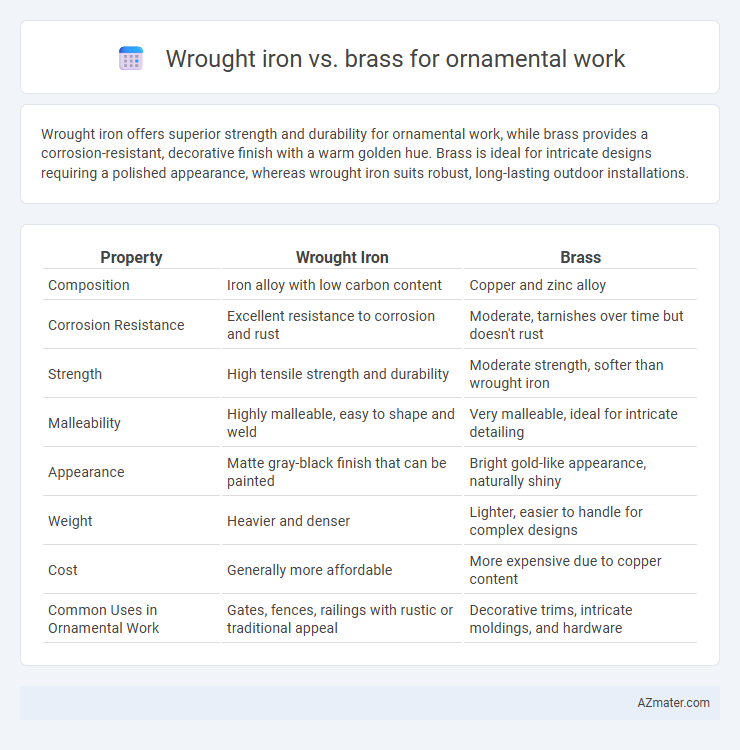Wrought iron offers superior strength and durability for ornamental work, while brass provides a corrosion-resistant, decorative finish with a warm golden hue. Brass is ideal for intricate designs requiring a polished appearance, whereas wrought iron suits robust, long-lasting outdoor installations.
Table of Comparison
| Property | Wrought Iron | Brass |
|---|---|---|
| Composition | Iron alloy with low carbon content | Copper and zinc alloy |
| Corrosion Resistance | Excellent resistance to corrosion and rust | Moderate, tarnishes over time but doesn't rust |
| Strength | High tensile strength and durability | Moderate strength, softer than wrought iron |
| Malleability | Highly malleable, easy to shape and weld | Very malleable, ideal for intricate detailing |
| Appearance | Matte gray-black finish that can be painted | Bright gold-like appearance, naturally shiny |
| Weight | Heavier and denser | Lighter, easier to handle for complex designs |
| Cost | Generally more affordable | More expensive due to copper content |
| Common Uses in Ornamental Work | Gates, fences, railings with rustic or traditional appeal | Decorative trims, intricate moldings, and hardware |
Introduction to Ornamental Metalwork
Ornamental metalwork utilizes both wrought iron and brass for their unique aesthetic and structural qualities. Wrought iron offers high tensile strength and malleability, ideal for intricate designs and outdoor durability, while brass provides corrosion resistance and a distinctive golden hue, enhancing decorative appeal. Selecting between wrought iron and brass depends on the desired balance of strength, weather resistance, and visual impact in ornamental projects.
Overview of Wrought Iron
Wrought iron, known for its toughness and malleability, is a popular choice in ornamental work due to its ability to be easily shaped into intricate designs without breaking. It contains very low carbon content, which increases its corrosion resistance compared to cast iron, making it suitable for both indoor and outdoor decorative applications. Its fibrous texture provides excellent weldability and durability, distinguishing it from brass, which is softer and more prone to scratches and dents.
Overview of Brass
Brass, an alloy of copper and zinc, is widely favored for ornamental work due to its excellent malleability, corrosion resistance, and attractive golden appearance that enhances decorative appeal. Its ease of casting and finishing allows for intricate designs and fine detailing often sought in ornamental pieces, making it suitable for applications like architectural fittings, musical instruments, and decorative hardware. Compared to wrought iron, brass offers superior resistance to rust and requires less maintenance, ensuring longevity and sustained aesthetic quality in both indoor and outdoor environments.
Visual Aesthetics: Wrought Iron vs Brass
Wrought iron offers a classic, rustic visual appeal with its dark, matte finish and intricate, handcrafted patterns that enhance garden gates and railings. Brass provides a bright, warm golden sheen with high reflectivity, making it ideal for ornamental pieces that require a luxurious and polished appearance. Choosing between wrought iron and brass for ornamental work depends on whether a traditional, robust look or an elegant, shimmering finish is desired.
Durability and Strength Comparison
Wrought iron offers superior durability and strength for ornamental work due to its high tensile strength and resistance to wear, making it ideal for intricate gates and railings exposed to outdoor elements. Brass, while aesthetically pleasing with its golden-yellow hue, is softer and more prone to scratches and dents, reducing its effectiveness in high-stress applications. For long-lasting ornamental structures requiring robust strength, wrought iron remains the preferred choice.
Maintenance Requirements
Wrought iron for ornamental work demands regular maintenance, including rust prevention through painting or sealing and occasional rust removal to preserve its durability and appearance. Brass, while more resistant to corrosion, requires periodic cleaning and polishing to maintain its shine and prevent tarnishing caused by exposure to air and moisture. Choosing between wrought iron and brass depends on the willingness to invest time in upkeep, with wrought iron needing more frequent attention compared to the relatively low-maintenance brass option.
Customization and Workability
Wrought iron offers exceptional malleability and can be easily heated and hammered into intricate, custom ornamental designs, making it ideal for detailed, personalized work. Brass provides superior ease of machining and casting, allowing for precise customization with smooth finishes and a range of decorative textures. Both materials excel in workability, but wrought iron is preferred for robust, hand-forged elements, while brass suits finely detailed, polished ornamental pieces.
Cost and Value Considerations
Wrought iron offers durability and a classic aesthetic at a generally lower initial cost compared to brass, making it a cost-effective choice for ornamental work with high structural value. Brass features a distinctive golden appearance and natural corrosion resistance, often leading to higher upfront costs but increased long-term value due to its low maintenance and lasting appeal. Budget considerations should weigh wrought iron's strength and affordability against brass's premium look and longevity to determine the best value for ornamental projects.
Popular Applications in Ornamental Design
Wrought iron is widely favored for ornamental gates, railings, and furniture due to its durability and intricate craftsmanship capabilities, providing strong and classic decorative elements in architectural design. Brass is often used in ornamental fixtures such as lamp fittings, door handles, and ornate plaques, valued for its corrosion resistance and attractive golden sheen that enhances aesthetic appeal. Both materials serve distinct roles in ornamental design, with wrought iron emphasizing structural artistry and brass highlighting decorative detail.
Choosing the Right Material for Your Project
Wrought iron offers durability, strength, and a traditional aesthetic, making it ideal for outdoor ornamental work such as gates, fences, and railings due to its resistance to impact and weather. Brass provides a rich, golden appearance with excellent corrosion resistance and malleability, favored for intricate indoor decorative elements like lighting fixtures, hardware, and sculptures where fine detail and a classic look are priorities. Selecting the right material depends on project requirements, environment exposure, desired visual appeal, and maintenance considerations, with wrought iron suited for robustness and brass excelling in detailed craftsmanship and elegance.

Infographic: Wrought iron vs Brass for Ornamental work
 azmater.com
azmater.com